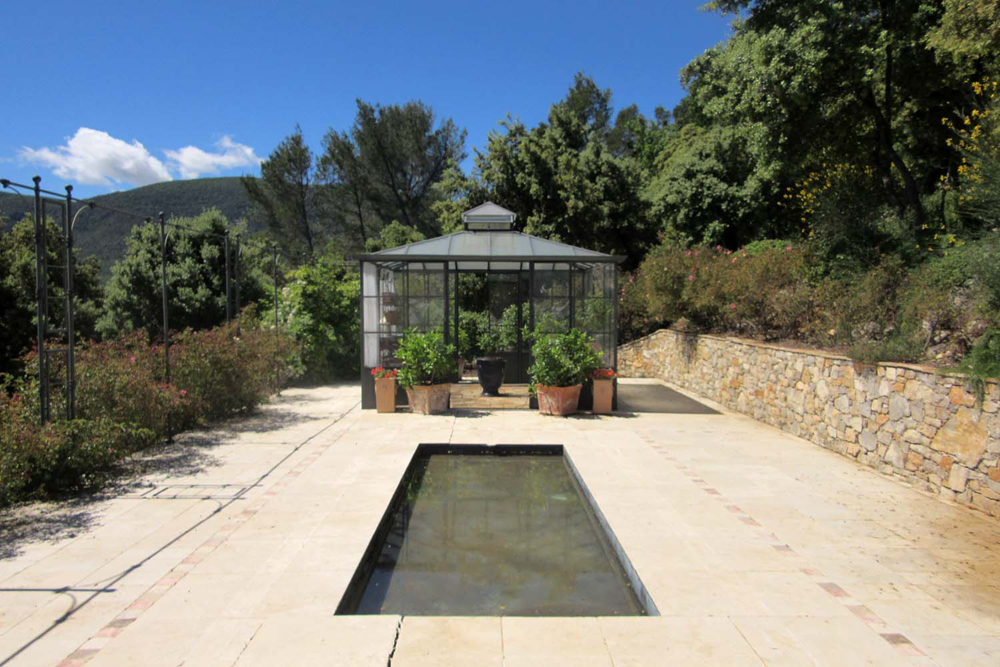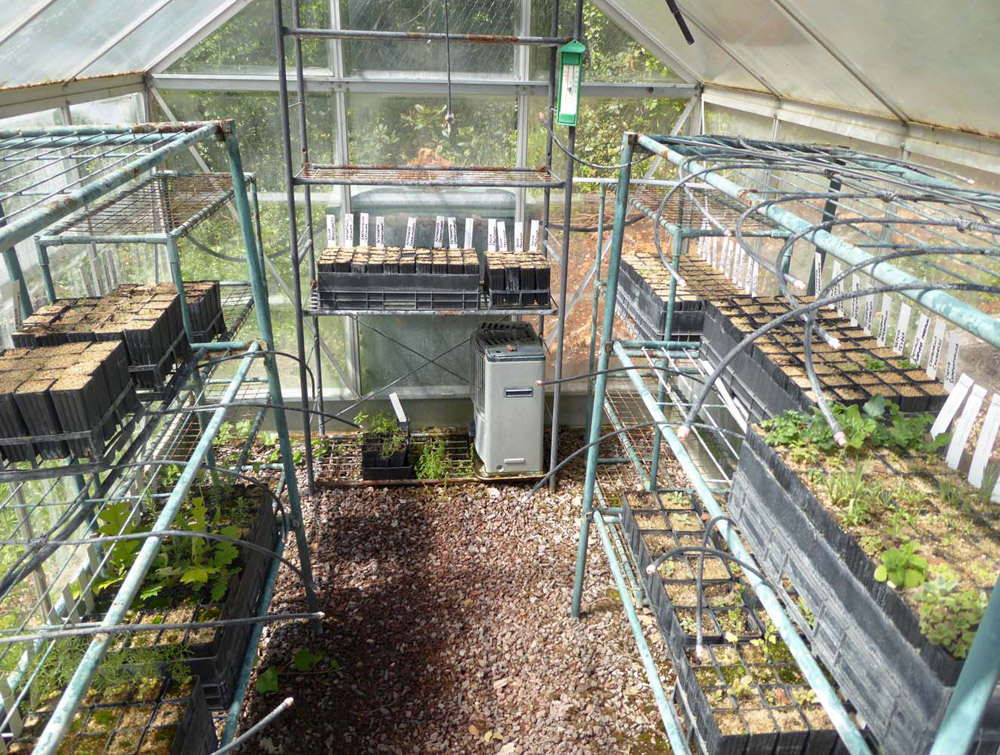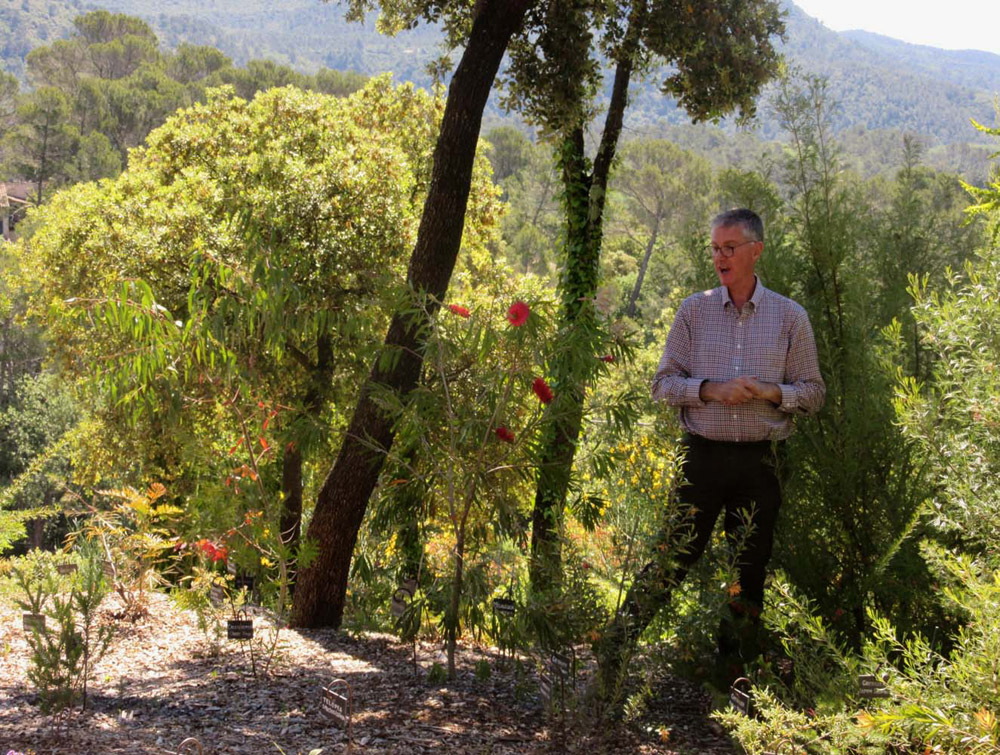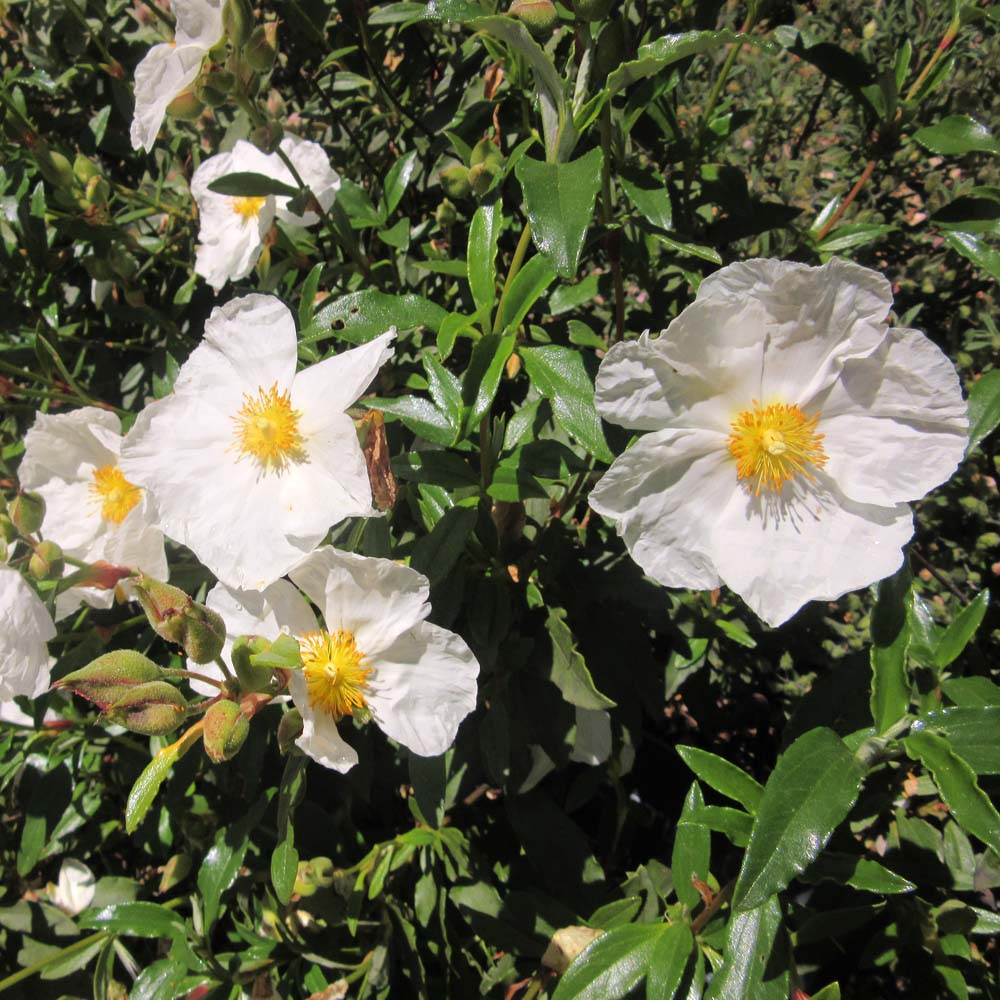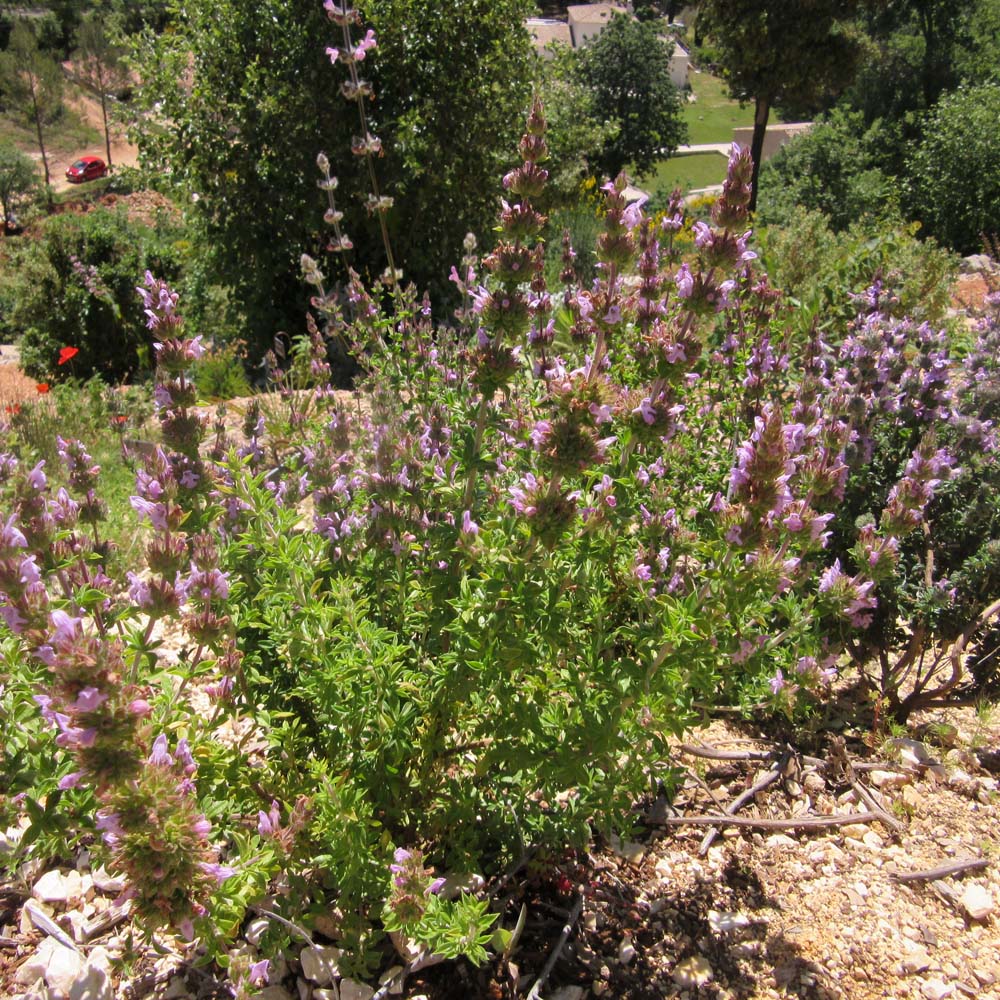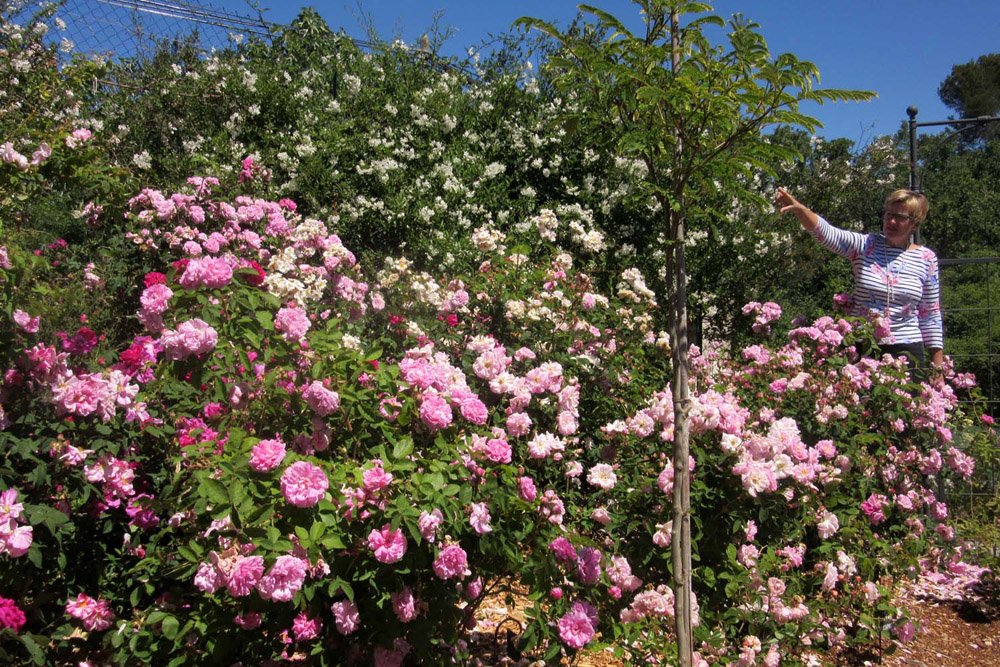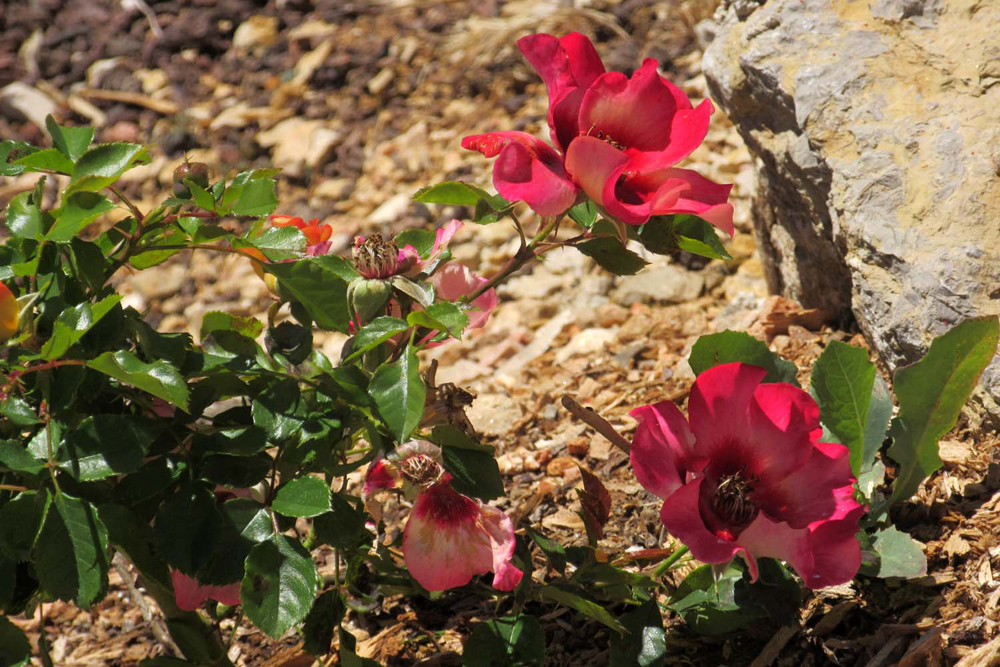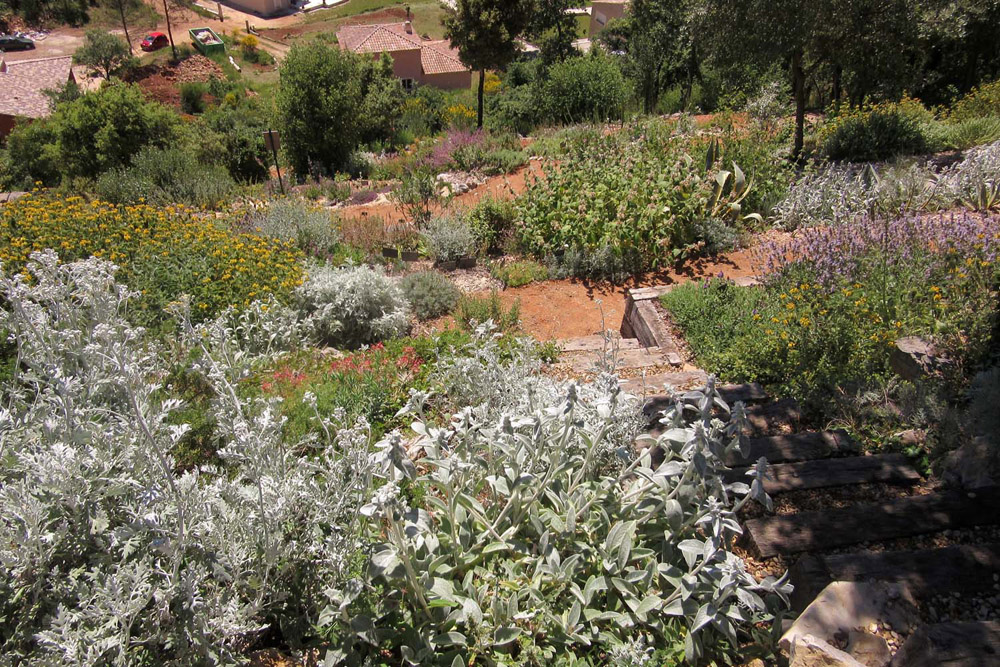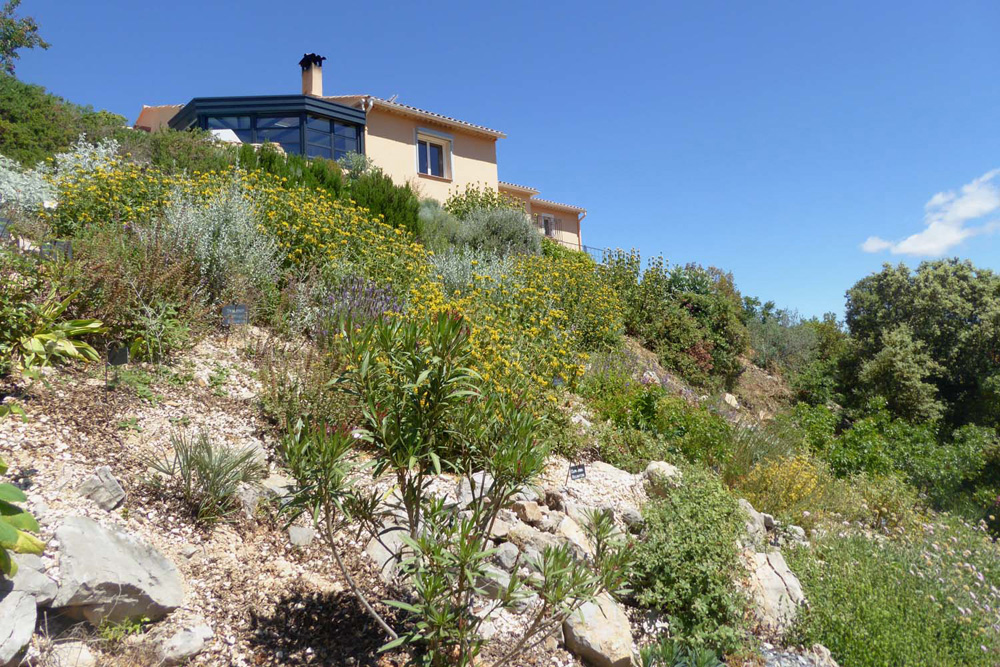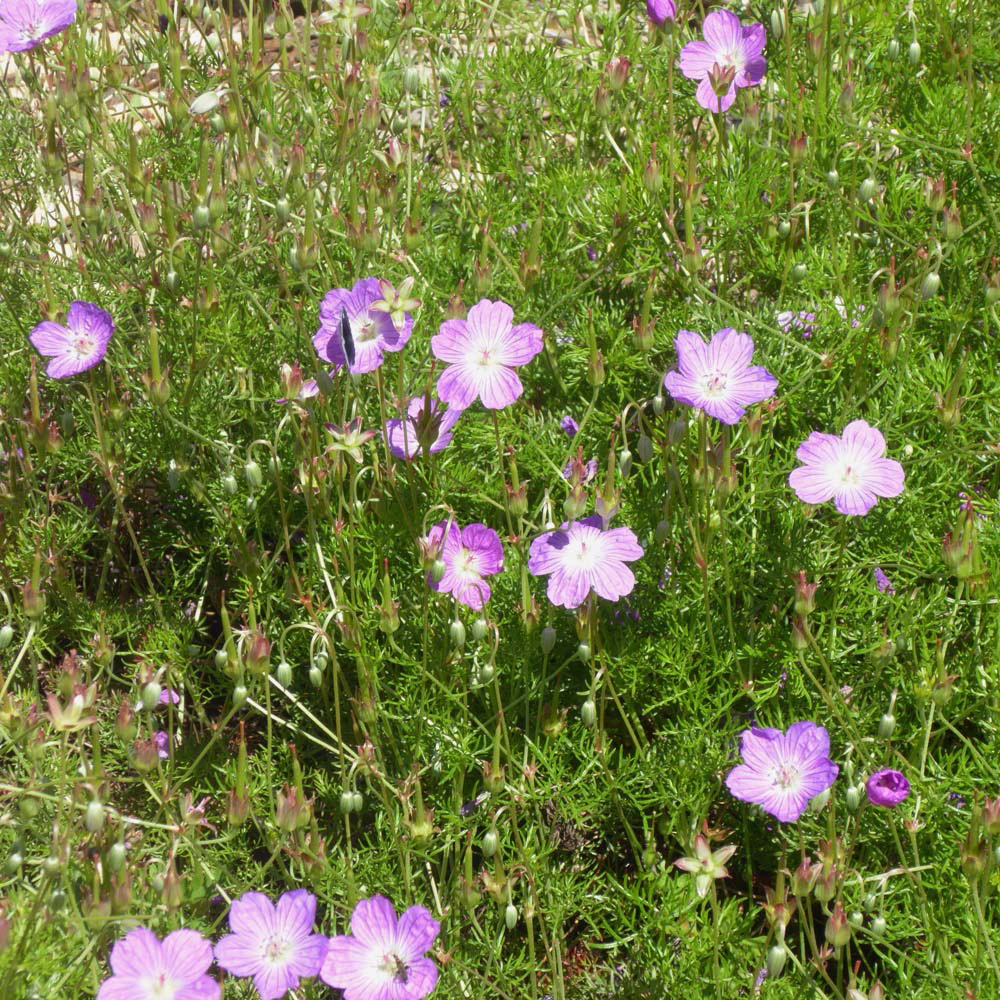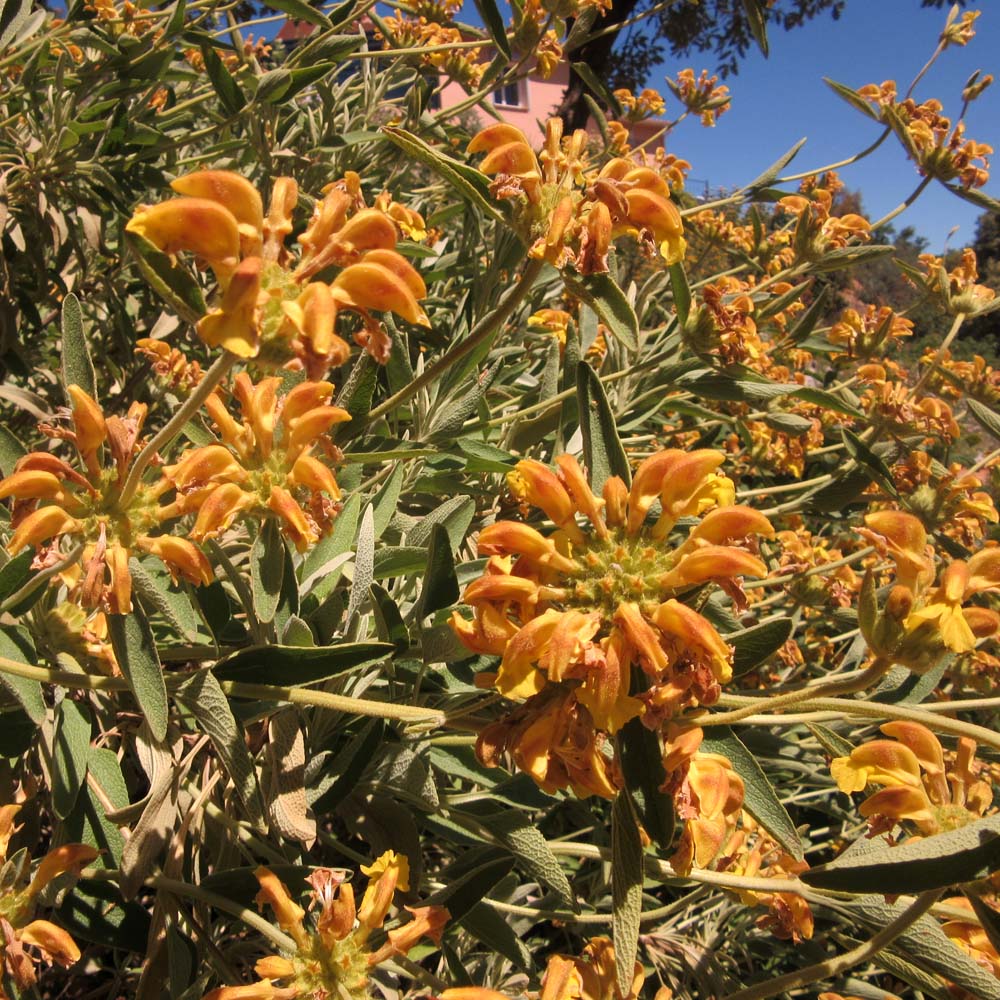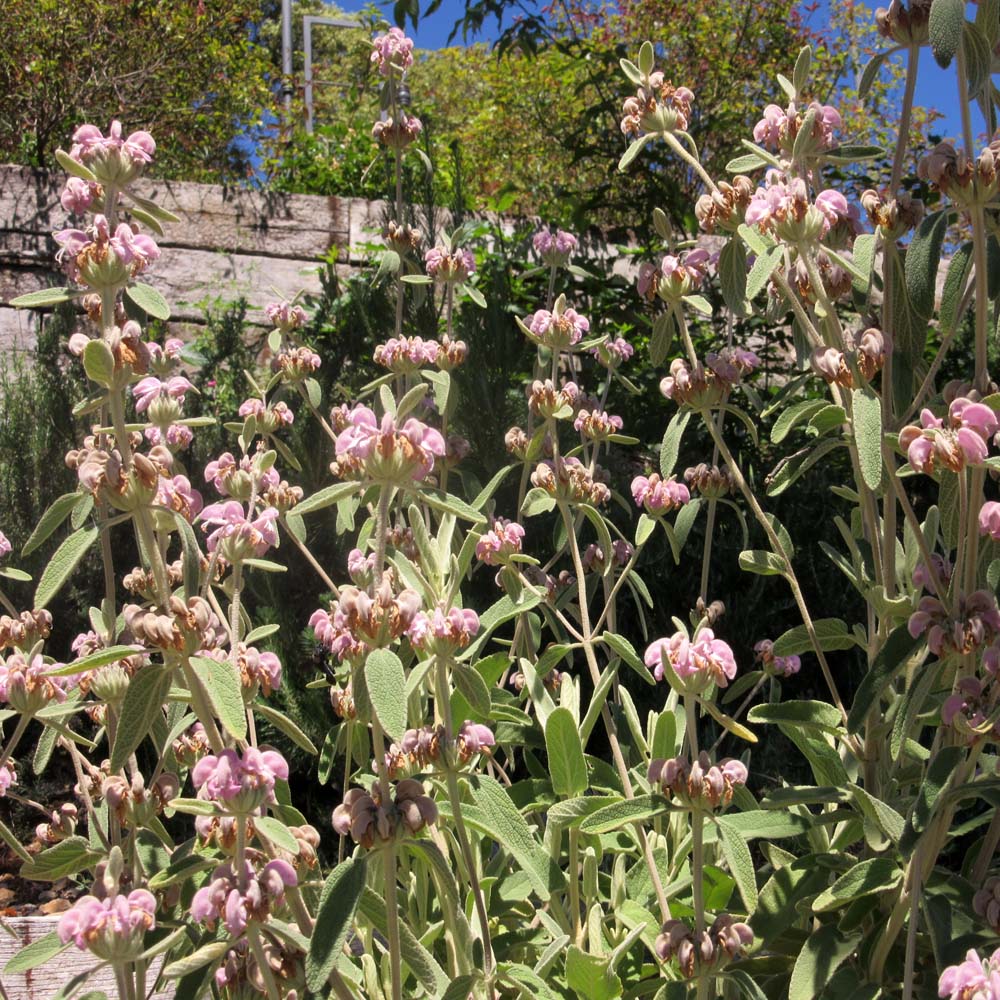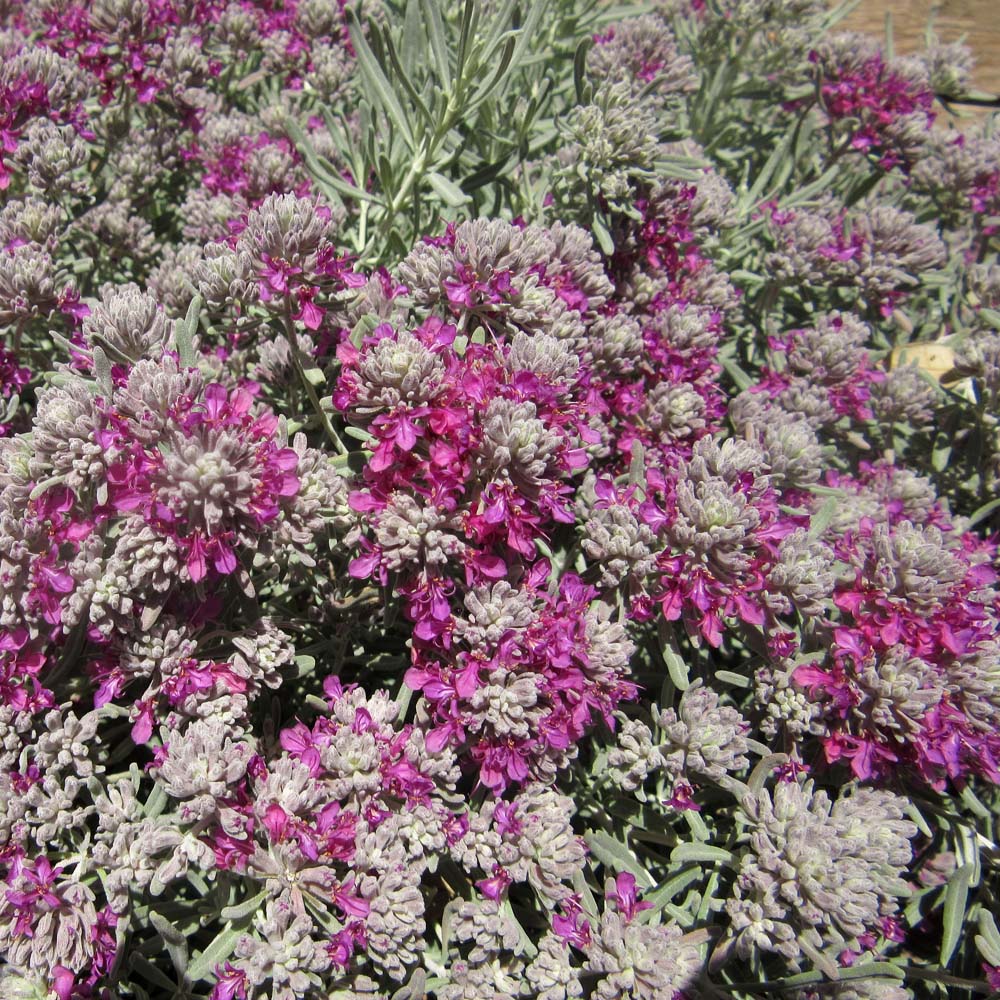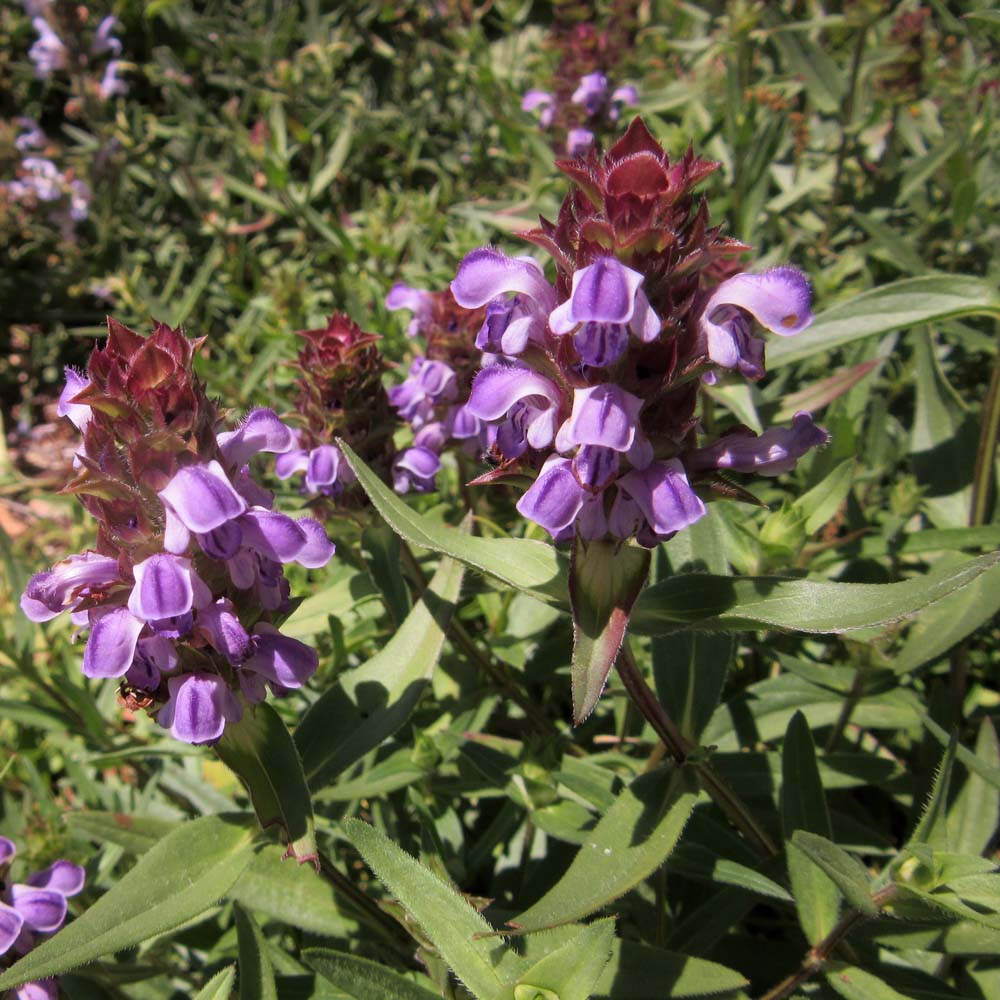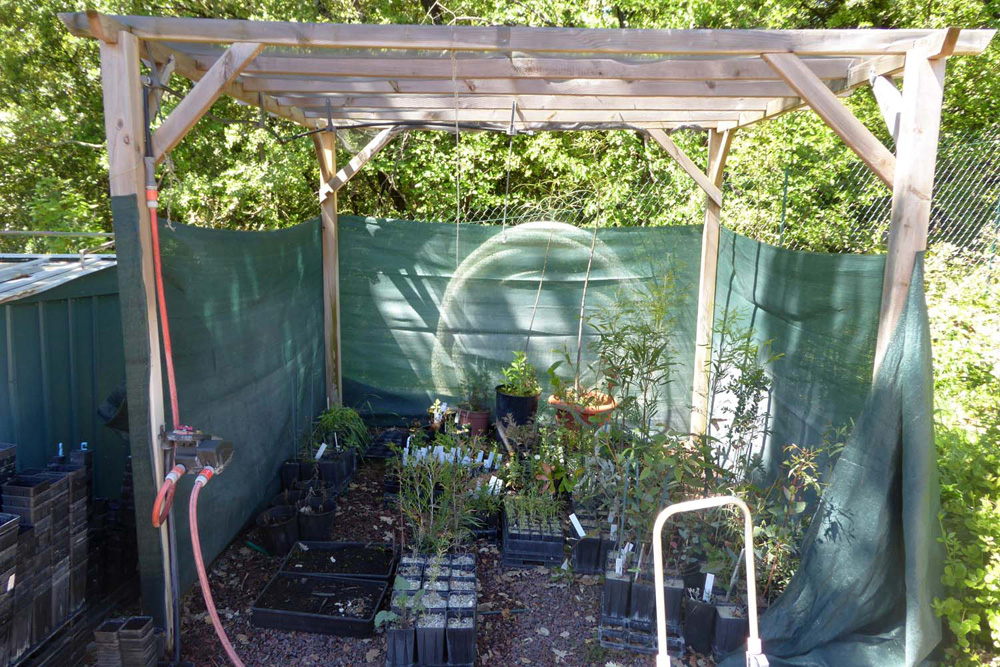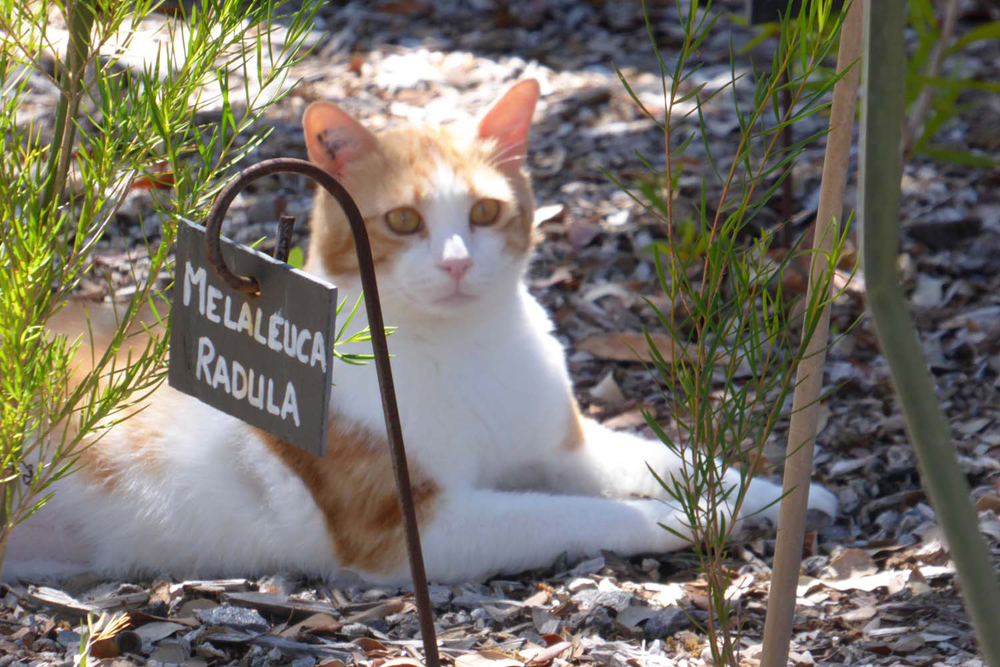May / mai 2017
A visit to Jacqueline and David Potter’s garden in the Var
Click on the images to enlarge them / Cliquez sur les images pour les agrandir
On entering David and Jacqueline Potter’s garden, you could be forgiven for assuming that the couple had taken early retirement, worked tirelessly seven days a week, with regular hired help, to create, develop and maintain their steep, sunny hillside garden. But you would be wrong on all counts. Not only do the Potters work full-time, and not just down the road, so that they could pop back at lunchtime to tend the greenhouse, but the other side of the world. How they have achieved such spectacular results, on a site that most of us would have given a wide berth to, beggars belief.
I know that several of the MGF members visiting the garden for the first time were excited about what they might see; but for me it was particularly thrilling, as the Potters’ garden was one of the first places I worked in when I arrived in France nearly seven years ago. At that time the Potters had already seen their early work destroyed, firstly by fire and then a landslide. Most of us, I suspect, would have called it a day, but not David and Jacqueline. When I arrived, they had re-planted behind the house, had some beautiful walls built by a couple of local craftsmen, had carved their way down the hillside and created an exquisite ‘Moorish’ terrace with a rill/basin and conservatory.
Jacqueline was in the process of surrounding it all with Rosa chinensis f. mutabilis and planting a couple of sentinel Italian cypresses. I was there to help David build some raised vegetable beds and terraces lower down the slope which we then filled with the first of the 360 tonnes of imported soil this garden has now consumed. The three of us erected a small greenhouse and argued endlessly as to why each time we passed it, another sheet of rigid plastic would pop out of its fixings. We must have done something wrong, but what? On this visit, I was glad to see the greenhouse fully-glazed and still in use.
I was equally smug about the raised beds I helped to build, looking as good seven years on as they did on completion. I pointed out my contributions to the garden to any members who would listen; most didn’t. The fact that these small parts of the garden are still standing are a testament to David’s civil engineering skills, rather than my blood, sweat and tears.
We started our tour around le parking, where David has his Australian area. It must be said that David is a keen plantsman, and much of the garden is dedicated to zones with plants from various countries of the world: California, South Africa and Turkey to name a few. They are mostly areas with a Mediterranean climate, but not exclusively so.
It was clear, as both Jacqueline and David took it in turns to explain the different plantings, that each had their fortes, though Jacqueline pointed out that David was the walking encyclopaedia, whereas she simply enjoyed the plants. Between leaving ‘Australia’ and visiting ‘the Canary Islands’ with David, Jacqueline took over to explain her love of the genus cistus, and other native Mediterranean plants.
Those of us who have tried to garden here for some time have come to realise the benefits of using plants in our gardens that thrive with the minimum of effort from us. Rosemary, sun roses, cistus , thymes, Spanish brooms etc. will all survive despite you disappearing off to Northern Europe to avoid the heat of the summer.
As we descended the hillside, I got distracted by photography and the thought of lunch, so missed much of the discussion on arrosage though I did hear David explaining their generous watering methods when planting new plants in the garden. He also mentioned that they like to plant in the autumn; if only a few more pépinièristes would take note. One French nurseryman who was there (Olivier Dupont) looked, I thought, a little sheepish. With the exception of the roses, the garden receives little summer irrigation. A few plants near the house may receive a monthly soak, but generally speaking the Potters have chosen plants which, once established, can survive these arid conditions.
An area by the deuxième entrée was totally undeveloped seven years ago, but Jacqueline has unleashed her passion for roses here. I was delighted to see Rosa ‘Ispahan’ thriving, a rose I’ve grown successfully both in the south of France and in the Cotswolds. Jacqueline told us that they had bought many roses from various nurseries in the UK, Holland and Germany, as well as France, but felt that the rootstocks chosen by some of the British nurserymen didn’t cope well with the conditions here. She strongly recommended a German nursery near Frankfurt, Rosen von Schultheis (the website is only in German). I’m not up to date with current rose production methods or rootstocks used, so I can’t really comment. Personally, I prefer roses to be grown on their own roots; my Rosa ‘Ispahan’ in France was taken as a cutting from the UK and simply stuck into the ground here. Jacqueline’s roses were spectacular at the time of our visit, as the photos testify.
In a separate area, Jacqueline was experimenting with some new hybrids of Rosa persica (syn. Hulthemia berberifolia), which grows wild in parts of Iran and Afghanistan. The new series of roses have been bred for their dark centres, or ‘eyes’ and they can be obtained from Dutch producer Tuincentrum Lottum.
Onwards and downwards, as we continue our tour.
My stomach is rumbling so I remain at the back of the group. Storms had been predicted for the day of our visit, so I had jettisoned my sunglasses and sun-hat and had filled the car with umbrellas, waterproofs and wellies. I find photography in bright sunlight difficult and the results disappointing, so was rather cheered by the thought of some dramatic rain-filled clouds. As it was, we were greeted by wall to wall blue skies, and my photographs suffered as a result.
One of the plants we all admired and photographed was Geranium incanum. I’m a great fan of the genus Geranium, but have struggled to grow many well in France. This one though was thriving and I intend to get some seeds as soon as I can. David told us that the seed source for this and many of their other South African varieties is the seed room at the Kirstenbosch Botanical Garden. Another genus which was thriving on this challenging site was phlomis. David clearly has a soft spot for them as he grows many species here. Some I was familiar with, others were new to me.
Other plants we admired:
What little soil there is here is typical of the region, an alkaline clay, rapidly turning from a sticky mess in winter to concrete in summer. As many of David’s plants require a neutral or acid soil, he has scoured the quarries of France in a quest for the perfect substrates. Merely tipping the imported soil on the ground is a waste of time, as it quickly slides down the hillside. Hence the large terraced beds I helped construct all those years ago, but on a smaller scale, David has pinned railway sleepers to the ground with metal rods, and then poured his chosen soil above them. Only then can he try to establish his new plantings.
It was interesting to see how David and Jacqueline set about clearing new areas for future development. First, the scrub and weeds are cut-back or strimmed hard to the ground, and then subsequent fresh growth is treated with an herbicide to kill or at least weaken the unwanted plants. Some of the more aggressive weeds eg Smilax aspera, the bane of every Mediterranean gardener, are hardly touched by glyphosate-based weed killers such as the ever-popular Round-Up. Their answer was to use a product that I had never heard of, acide pelargonique, though it was clear that other members of our group had come across it. Apparently, it is derived from pelargoniums, works within 24 hours and needs careful handling as it is totally non-selective, but the eye-wateringly high price of the product will ensure that.
I fear my words haven’t done the Potters’ garden justice. Too much fiddling with my camera and chatting to fellow gardeners are to blame, that and the thought of lunch – we were not disappointed. But perhaps David and Jacqueline will invite us back before another seven years pass. Let’s hope so. I’ll know just what to expect next time.
Text: Peter Dinning
Photos: Peter Dinning, Joan Jenkin and Christine Daniels
To follow Peter’s report, here are a few words from the Potters themselves:
We had a great day ourselves and enjoyed the visit of so many members who were genuinely interested in an ‘unfinished garden’. We like to exchange ideas and learn from others. For those who would like to collect seeds from any of the plants, in August we spend several weekends cutting back the seed heads of all plants. We then lie them on the ground in bunches, mixed with dried leaves or leaf mulch, in places where we want them to multiply. We’ve learned that this creates, once the rain comes back, a micro climate, a ‘humid bed’, for the seeds to develop. This method has a much higher success rate than just scattering seeds (sometimes even higher than multiplying them in pots) . If you would like some seeds from our plants, please don’t hesitate to call us and plan to come by in August. Tel 0494489079/0632456187.
In regards to our garden ’substrat’, there were many questions about it. It is called ‘tout venant’ and is well known by the French. It’s a mix of crushed stone and clay, is used by builders in general and we get it from a builders’ place close by. It comes from quarries in the neighbourhood. The redder the better is what we learned as it holds more red clay and is more neutral. The black one is the most acid and comes from near Collobrières. The red and yellow one comes from Signes or Brignoles quarries. Any tout venant mixture works better for plants than brought up black soil and holds the water better. It works for all types of plants including all the roses we have. And it’s cheaper.
Jacqueline and David Potter
![]()

